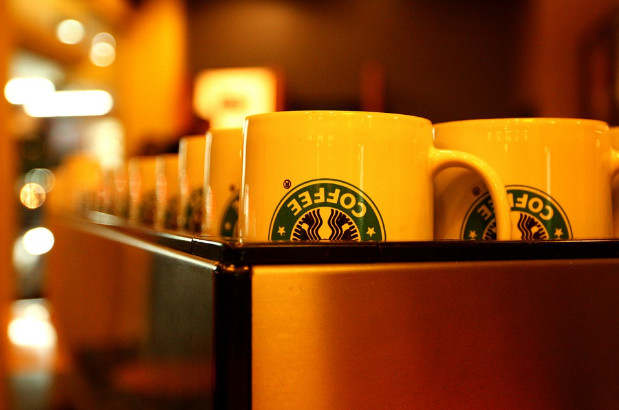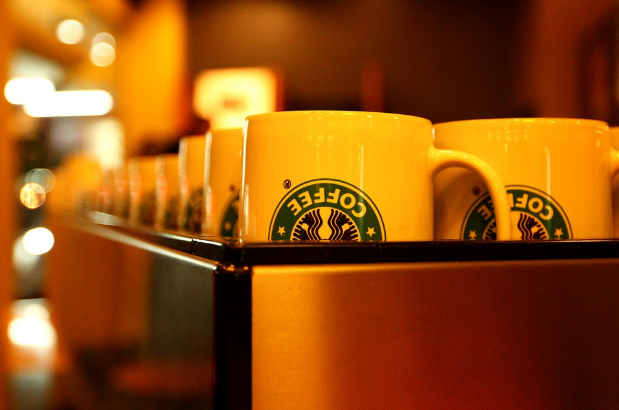
After fat years of 2009 to 2015, shares of the coffeemaker dropped by 8% in 2016 for no discernible reason. At that, market grew by 10% in total.
A skeptic might point to a slowdown in sales growth, uncertainty after Schultz’s announcement about his (second) retirement or even the company's intention to rely on foreign sales as Donald Trump proclaimed protectionism a cornerstone of his policies.
However, even short-term problems are not obscuring the law of large numbers. A large company like Starbucks, with revenues of approximately $ 21 billion and nearly 26 thousand stores in 75 countries, is doomed to have difficulties with long-term pace of growth.
Financial results of Starbucks for the last quarter only make the situation more mysterious. Comparable sales in the US (this indicator measures performance of stores opened more than a year ago) in the IV quarter increased by 3% compared to last year. At the same time, research firm Texas TDn2K reports that sales in the restaurant industry as a whole decreased by 2.4% for the period.
Sara Senatore of AB Bernstein says: "Many other food service networks simply would kill for that kind of results." However, Starbucks is failing by its own standards. A year ago, same-store sales rose 9%. Once the report was published, investors have sought to flee, knocking the price of shares down by 7%. Some of long-term changes within the company also contributed to the slower growth. Launch of food division, which now accounts for about 20% of sales, was smooth, so the growth in this segment will no longer outperform the market.
Starbucks also suffered from disruptions related to the loyalty programme. In hope to speed the service up, the company began to give away food and drinks basing on amount of customer spending, rather than on number of visits to the cafe. However, things did not go as smoothly as planned. Now the loyalty programme unites 12.9 million people, yet number of participants is growing slower than expected. Starbucks describes these difficulties as a small hiccup on the way up.
Over the past year, the company opened 884 restaurants in the USA, and now their number exceeds 16 thousand. In China, Starbucks is opening a new coffee shop every 15 hours, and sales in this country are the main driver of growth. By 2021, the company plans to increase number of outlets by 37 thousand, thus outstripping McDonalds by this indicator.
However, size is a double-edged weapon. It is hard to keep an outstanding pace when you are that big, says Jeffrey Bernstein of Barclays Capital. Starbucks expects sales growth in the region of 4-6% in 2017, while analysts forecast 4%. One way or another, the number will outpace overall growth in the restaurant industry.
Starbucks’ ability to achieve this goal will depend, in part, on Howard Schultz. He is stepping down in April, leaving his post to current Chief Operating Officer Kevin Johnson.
This is not the first time when Schultz is leaving. In 2000, he resigned as CEO to focus on a global strategy for Starbucks. International sales, almost insignificant at the time, now bring 26% of revenue to the company.
Starting from this year, Schulz is planning to launch a chain of premium coffee houses for gourmets. Now there’s only one such restaurant. The company intends to open 1,000 locations around the world, and mini-versions of the new cafes in 20% of their normal locations.
Some investors find it particularly satisfying that Starbucks is expanding its range while business is still growing, rather than waiting for a recession. Even those who believe in the company’s potential will have to pay a high price if they want to buy its shares today. The company's capitalization is 26 times higher than estimated income for 2017. For the S&P 500, the figure is 19, and both, the stocks and the index, are expensive compared to average historical data.
source: fortune.com
A skeptic might point to a slowdown in sales growth, uncertainty after Schultz’s announcement about his (second) retirement or even the company's intention to rely on foreign sales as Donald Trump proclaimed protectionism a cornerstone of his policies.
However, even short-term problems are not obscuring the law of large numbers. A large company like Starbucks, with revenues of approximately $ 21 billion and nearly 26 thousand stores in 75 countries, is doomed to have difficulties with long-term pace of growth.
Financial results of Starbucks for the last quarter only make the situation more mysterious. Comparable sales in the US (this indicator measures performance of stores opened more than a year ago) in the IV quarter increased by 3% compared to last year. At the same time, research firm Texas TDn2K reports that sales in the restaurant industry as a whole decreased by 2.4% for the period.
Sara Senatore of AB Bernstein says: "Many other food service networks simply would kill for that kind of results." However, Starbucks is failing by its own standards. A year ago, same-store sales rose 9%. Once the report was published, investors have sought to flee, knocking the price of shares down by 7%. Some of long-term changes within the company also contributed to the slower growth. Launch of food division, which now accounts for about 20% of sales, was smooth, so the growth in this segment will no longer outperform the market.
Starbucks also suffered from disruptions related to the loyalty programme. In hope to speed the service up, the company began to give away food and drinks basing on amount of customer spending, rather than on number of visits to the cafe. However, things did not go as smoothly as planned. Now the loyalty programme unites 12.9 million people, yet number of participants is growing slower than expected. Starbucks describes these difficulties as a small hiccup on the way up.
Over the past year, the company opened 884 restaurants in the USA, and now their number exceeds 16 thousand. In China, Starbucks is opening a new coffee shop every 15 hours, and sales in this country are the main driver of growth. By 2021, the company plans to increase number of outlets by 37 thousand, thus outstripping McDonalds by this indicator.
However, size is a double-edged weapon. It is hard to keep an outstanding pace when you are that big, says Jeffrey Bernstein of Barclays Capital. Starbucks expects sales growth in the region of 4-6% in 2017, while analysts forecast 4%. One way or another, the number will outpace overall growth in the restaurant industry.
Starbucks’ ability to achieve this goal will depend, in part, on Howard Schultz. He is stepping down in April, leaving his post to current Chief Operating Officer Kevin Johnson.
This is not the first time when Schultz is leaving. In 2000, he resigned as CEO to focus on a global strategy for Starbucks. International sales, almost insignificant at the time, now bring 26% of revenue to the company.
Starting from this year, Schulz is planning to launch a chain of premium coffee houses for gourmets. Now there’s only one such restaurant. The company intends to open 1,000 locations around the world, and mini-versions of the new cafes in 20% of their normal locations.
Some investors find it particularly satisfying that Starbucks is expanding its range while business is still growing, rather than waiting for a recession. Even those who believe in the company’s potential will have to pay a high price if they want to buy its shares today. The company's capitalization is 26 times higher than estimated income for 2017. For the S&P 500, the figure is 19, and both, the stocks and the index, are expensive compared to average historical data.
source: fortune.com


















